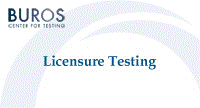Buros-Nebraska Series on Measurement and Testing

Licensure Testing: Purposes, Procedures, and Practices
Date of this Version
1995
Document Type
Article
Citation
Licensure Testing: Purposes, Procedures, and Practices, ed. James C. Impara (Lincoln, NE: Buros Institute of Mental Measurements, University of Nebraska-Lincoln, 1995).
Abstract
Testing candidates with disabilities, testing repeaters, and coaching involve issues of fairness, the validity of the inferences made from test scores, and protection of the public. Licensing boards must develop policies to deal with each of these issues. It is interesting to note that although all three are of concern to licensing agencies, little of the research on these topics has been conducted in licensure settings. This chapter discusses the results of research conducted on each topic, considers the psychometric implications for policy of each, and suggests steps licensing boards can take when formulating policy.
TESTING CANDIDATES WITH DISABILITIES IN LICENSURE SETTINGS
Disabled examinees take tests to apply for college, graduate school, and to be licensed or certified. Their ability to perform well on these examinations can be severely limited if the testing conditions or test format interact with their disability, but are not required for performance in school or on the job.
Most licensing agencies have been providing examinations in facilities accessible to disabled candidates, and have been providing alternative forms of examinations for many years (Schmitt, 1991). Accommodations for college entrance examinations have been made since the 1930s (ETS, 1988). In 1937, a version of the Scholastic Aptitude Test was developed for students who are visually impaired. The College Board, with the assistance of the American Foundation for the Blind, developed a braille booklet containing 100 antonyms, 50 analogies, and 50 reading comprehension items. A "talking book" record was also introduced which contained additional reading comprehension passages and questions. A braille practice booklet was developed to provide an opportunity for blind students to review the concepts covered by the test prior to taking the examination. Testing agencies had been providing accommodations to candidates from special populations, based primarily on the agencies' commitment to fairness and equal opportunity. The passage of the Americans with Disabilities Act (ADA) PL 101- 336 now requires licensing agencies to provide appropriate accommodations for disabled test candidates. This legislation is likely to result in increased numbers of candidates requesting accommodations, and in licensing agencies providing them. The following section focuses on the requirements of the ADA that are related to testing, and the psychometric implications of these requirements.
The ADA
The ADA was enacted on July 26, 1990. It contains five major parts or titles. The act provides comprehensive civil rights protection to disabled individuals in the areas of employment, public accommodations, state and local government services, transportation, and telecommunications. Its intent is to increase job opportunities and access for disabled individuals. The testing requirements of the ADA took effect on January 26, 1992.
Title II of the ADA describes the responsibilities of state licensing agencies. It extends the prohibition of discrimination in federally assisted programs established by Section 504 of the Rehabilitation Act of 1973 (PL 93-112) to all activities of state and local governments, including those that do not receive Federal financial assistance. Title III delineates the responsibilities of private certification agencies. In general, the ADA emphasizes the need for (a) access to examination and course presentation facilities, (b) examination results that accurately reflect candidates' levels of knowledge or skill rather than their disabilities, and (c) administration of examinations for disabled candidates as often, and in as timely a manner, as examinations for nondisabled examinees. The section on examinations is quoted at length to provide examples of the language included in tile ADA.
Included in
Adult and Continuing Education and Teaching Commons, Educational Assessment, Evaluation, and Research Commons, Other Education Commons


Comments
Copyright © 1995 by Buros Institute of Mental Measurements. Digital Edition copyright © 2012 Buros Center for Testing.